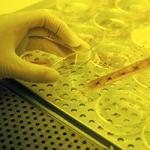
Research Topics
1. Multivalent Presentation of Tumor-Associated Carbohydrate Antigens (TACA) and TACA-Peptide Conjugates as Novel Anticancer Agents
Carbohydrates are presented on the surface of cells primarily in covalent linkages to proteins (glycoproteins, proteoglycans) or lipids (glycolipids, gangliosides). These diverse groups of oligosaccharide chains function to stabilize protein structures, facilitate protein transport or clearance, and mediate cell adhesion. Cell-surface glycans may reveal or mask peptide epitopes on proteins or be recognized as immunogenic structures themselves. During oncogenesis, the cell-surface glycans on tumor cells are transformed relative to the normal phenotype through modified expression of the enzymes involved in the cell's glycoprocessing machinery. These aberrations are a hallmark of highly tumorigenic and metastatic cell types. The cascade of events leading to tumor metastasis is marked by the alternate adhesion and release of the tumor cell with a variety of surrounding cell types. The binding between tumors and other cell types is often mediated by carbohydrate-protein (lectin) interactions involving the aberrant glycans expressed on tumor cells. Inhibition of these adhesion events could slow or prevent metastatic spread. In addition, some of these tumor cell glycans are TACA's that are recognized as non-self by the immune system and have thus been used as components in vaccine constructs that are in clinical trials. Since it is well known that monovalent sugar-protein binding is a very weak interaction, inhibitors of these events utilize 'multivalency' (multiple copies of the carbohydrate ligand) to enhance the strength of this effect.
We are exploring ways to synthesize novel templates on which to place multiple copies of the Thomsen Freidenreich (TF) antigen, a disaccharide O-linked to proteins found on the cell surface that is present in >90% of carcinomas but rarely found in normal tissue. We have developed a new synthesis of this antigen that is equipped with a chemically-defined specific linker to attach to macromolecules or other surfaces. We have coated the TF antigen to gold surfaces and Quantum Dots (QDs) in a variety of different presentations (simple linked TF, TF-amino acid conjugates and larger TF-containing glycopeptides) and showed that some of these construct have very interesting biological functions. In addition, our group developed an hybrid gold nanoparticle that can act as a vaccine delivery system for tumor-associated glycopeptide antigens. Our goal is to optimize these various nanoconstructs to enhance a glycopeptide-specific immune response that will be specific for distinct tumors bearing these antigens.
2. Antiproliferative Factor (APF): A novel antiproliferative glycopeptide from interstitial cystitis/bladder pain syndrome (IC/BPS) patients.
IC/BPS is a devastating bladder disorder characterized by frequency, urgency and severe pain,. A novel glycopeptide called APF was isolated from the urine of IC/BPS patients by the team of Susan Keay at the University of Maryland and and fully characterized and synthesized in our lab. APF treatment of normal bladder epithelial cells inhibits proliferation at sub-nanomolar concentrations, and imparts many features to these cells as seen in the actual disease. In addition, APF inhibits proliferation of bladder carcinoma and many other solid tumor cells at similar concentrations. We are presently synthesizing analogues of APF and have defined a structure activity relationship for the molecule. We are exploring analogues that may inhibit proliferation as treatments for IC/BPS or mimic APF activity with specificity for tumors as anticancer agents. Chemical biology techniques are being employed to study the biosynthesis and structural basis for the activity of this novel glycopeptide.
3. Conformational analysis of small molecules by NMR
Along with our group, The entire CBL synthesizes small molecule agents as potential anticancer or antiviral therapeutics. Our section uses NMR spectroscopy to determine 3-dimensional conformations of many of these candidates as an aid to structure-based drug design. Currently, a major area of research has focused on the different conformations imparted to peptides by various covalently linked TACAs/sugars. We discovered a distinct difference between the structures of glycosylated serine versus threonine---Serine-conjugated sugars are relatively free to explore the conformational space whereas threonine-coupled sugars are much more restricted. We are studying the biological consequences of these preferences in the context of different sugar-binding proteins.
Biography
Selected Publications
- Trabbic KR, Whalen K, Abarca-Heideman K, Xia L, Temme JS, Edmondson EF, Gildersleeve JC, Barchi JJ Jr. A Tumor-Selective Monoclonal Antibody from Immunization with a Tumor-Associated Mucin Glycopeptide. Sci Rep. 2019;9(1):5662.
- Siddiqui MA, Ambre S, Keay SK, Rhyne JM, Zhang CO, Barchi JJ Jr. Glycoamino Acid Analogues of the Thomsen-Friedenreich Tumor-Associated Carbohydrate Antigen: Synthesis and Evaluation of Novel Antiproliferative Factor Glycopeptides. ACS Omega. 2017;2(9):5618-5632.
- Biswas S, Medina SH, Barchi JJ Jr. Synthesis and cell-selective antitumor properties of amino acid conjugated tumor-associated carbohydrate antigen-coated gold nanoparticles. Carbohydr Res. 2015;405:93-101.
- Glinskii OV, Li F, Wilson LS, Barnes S, Rittenhouse-Olson K, Barchi JJ Jr, Pienta KJ, Glinsky VV. Endothelial integrin α3β1 stabilizes carbohydrate-mediated tumor/endothelial cell adhesion and induces macromolecular signaling complex formation at the endothelial cell membrane. Oncotarget. 2014;5(5):1382-9.
- Barchi JJ Jr. Mucin-type glycopeptide structure in solution: past, present, and future. Biopolymers. 2013;99(10):713-23.
Related Scientific Focus Areas
This page was last updated on Tuesday, November 19, 2024


